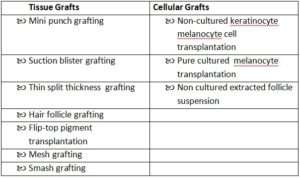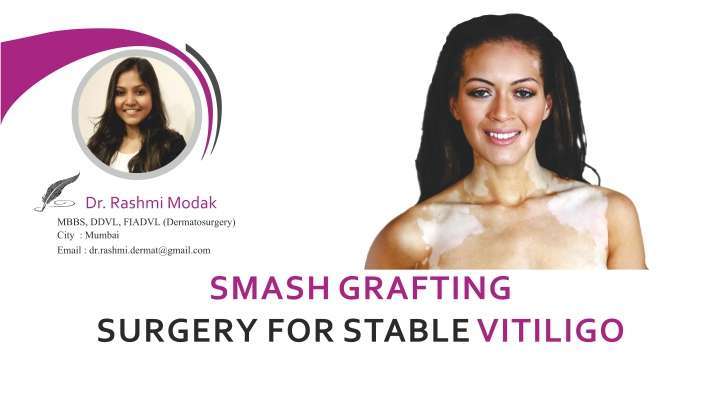Vitiligo is an acquired de-pigmentary disorder of great cosmetic significance occurring due to loss of skin pigment secondary to melanocyte damage. Various modalities of treatment including medical and other adjuvant therapies form a part of the primary management. However some patients are refractory to medical treatment, leading to tremendous psychological impact and affecting quality of life.
Surgical therapies can be used either alone or in conjunction with other therapies, to achieve re-pigmentation, provided the disease is stable. Surgical replacement of the damaged melanocytes – is collectively known as grafting procedures.
Grafting Techniques in Vitiligo:

Smash grafting, is a simple surgical technique, where in, the graft undergoes “smashing” before being applied to the recipient site, providing good colour and texture match post-surgery.
Indications:
- Patients with segmental, non-segmental, focal vitiligo that is stable for at least 12 months of duration.
- Disease refractory to standard medical & physical treatment (Phototherapy)
Contra-indication:
- > 30% body surface area involvement
- Pregnant females
- Keloidal /bleeding tendency
- Patients with unrealistic expectations
Procedure:
Anterior thigh preferred as the donor site. After cleaning with povidone iodine and 70% ethanol superficial graft about 1/10 of recipient area is taken and wound covered with antiseptic tulle dressing. Graft is transferred to petri-dish containing normal saline and smashed into small pieces with micro graft cutting scissor. A suspension is made containing skin fragments in normal saline. Recipient area is dermabraded with motor dermabrader and smashed graft suspension is applied evenly. The graft area is dressed with dry collagen sheets and antiseptic tulle dressing. Antibiotics and analgesics are prescribed for a week and patients are cautioned about any vigorous activity for two weeks. Dressing is removed after 1 week. Gradual pigmentation is seen in about 6-8 weeks.
Conclusion:
Smash Grafting is a variant of spilt thickness graft with slight modification. It is a simple procedure but lesser known due to lack of awareness. It gives optimum outcomes in difficult-to-re-pigment areas such as patches over bony prominences. Good response is seen on patches over face and neck where usually cellular grafting techniques are preferred. Few technical improvisations are required and the technique is easy to master. It is also a cost-effective option to cellular grafting techniques and less time consuming, giving equivalent results. Incidence of complications is low as compared to other grafting techniques including punch grafting. Small donor size is enough for larger areas.
Krishnan et al in 2010 found excellent to good results in 26 patients. Isolated case reports published have shown good results with smash grafting (combined with other methods). More publications are needed for its widespread application.
*-*-*






